Excerpted with permission from Reformation, Revolution and Rebirth: The Story of the Return of Catholicism to Reading and the Founding of St James' Parish by John Mullaney and Lindsay Mullaney (Reading: Scallop Shell Press, 2012), pp. 112-146, and reformatted for the Victorian Web by Jacqueline Banerjee. All images come from the book. Reproduction rights belong to the authors or to those indicated in the credits. Click on the images for larger pictures. For more information about the book, please visit the Scallop Shell Press website.
The Windows
Principle: "It will be readily seen that without a splay a considerable portion of light would be excluded, and that this form of jamb is necessary to the use and intention of a window."



Left to right: (a) Splayed and un-splayed windows, from True Principles (the shaded areas depict the masonry, with the dotted lines showing the line of the light). (b) Splayed window, St James' Church, photograph by C. Widdows. (c) Norman windows in a South Oxfordshire church.
The window openings at St James' follow this principle without equivocation. The overall result is a feeling of airiness. Wherever one sits in the nave at least two full windows and their light are visible. The above photo [centre] illustrates the validity of Pugin's claim about dispersing light. He is copying a style and technique frequently used in the Middle Ages, at a time when glass was are very expensive. Small apertures served a double purpose. They were useful in maintaining an even temperature. They lessened heat loss in winter and heat gain in summer. Anyone visiting a church in Southern Europe will know how refreshing it is to step inside when the temperature is soaring outside. Should you visit the same church in winter, maybe with snow on the surrounding hills, then the interior, warmed even just by candles, retains its heat owing to the thickness of the walls and narrowness of its windows. Of course in Medieval Europe, as the structures became lighter, as glass became relatively less expensive and as windows became larger, this became less true. But in small, not very wealthy country churches, little changed.
The Glass

Apse Windows, [three individual] photographs by C . Widdows.
There are several examples of the original stained glass in the Church. The glass that fills the oculus in the West gable is unfortunately obscured by the organ. A fraction can be spotted at various angles within the church. For some time there has been discussion as to whether the existing apse windows are in fact the originals. There were claims that they had been removed for the duration of the Second World War and later replaced by different windows.
The internal evidence of the content of the windows, such as the use of the coats of arms of the various benefactors and the founder of the Church, would certainly indicate that they are indeed those originally installed. We know, for certain, that the brasses on the font were placed there at the time of the opening of the Church. An examination of these shows that the same heraldic devices are used on the brasses and in the windows. This gives us a very strong indication that they were designed at the same time. The possibility that the windows were made afterwards and merely copied these designs is lessened if we look at a contemporary report in the Tablet which gives a detailed description of them at the time of the Consecration of the Church in August 1840: "But in the whole and in the detail, the building is another trophy to the fame of the immortal architect. Immediately on passing the finely-wrought doors, the spectators eye is carried to the eastern end, where, under the noble arch of the sanctuary, stands the altar, presenting at the first view a blaze of glory. Directly over it are three painted windows, of which the softened brilliancy of colouring produces the effect of clustered precious stones."
It would be difficult to better the description: "the softened brilliancy of colouring produces the effect of clustered precious stones." Moreover we have the evidence of photographs taken in the 19th or very early 20th century of the interior of the church [see last picture on this webpage]. Although in black and white, the design of the windows and their patterns match those of the existing windows. It is quite possible that these were later additions or copies but the balance of probability rests with the conclusion that these are the original windows.
The Metalwork

From True Principles.
Pugin next examines what he calls "consideration of works in metal." He supplies his reader with copious examples and, as ever, lays down strict guidelines or "principles" suiting, as he puts it, "the design to the material and decorating construction." In other words his same initial three principles are to be applied as much to ironwork as to any other part of the building.
Locks, hinges, bolts, nails etc. should not be hidden. Their function is clear and they should be converted into things of beauty. Pugin points out that a modern hinge, shown at top right in the above plate, though hidden, is also weak. The same applies to locks and keys.
Leaves and crockets are not to "be carved or modelled and then cast." Rather they should be "cut out of thin metal plate and twisted up with pliers and the lines of stems either engraved or soldered on.... "Large tracery" should be "either formed of round iron, like a stem twisted into intersections, or of flat iron bars of different thicknesses riveted together, and the edges chamfered by filing."
Pugin acknowledges that cast iron is valuable for mechanical purposes but should never be used for ornamentation. This is especially true when cast iron is used in conjunction with stone. For example a stone pillar is bulky whilst a cast iron pillar is relatively slight. The result is a miss-match between the dimensions of the two materials. Consequently, because of its inherent volume, a "great inconsistency" in the relationship between the materials occurs. However, if the tracery is reduced in size to match the strength of the material, then it looks "painfully thin, devoid of shadow and out of proportion to the openings in which they are fixed." Another fault, as Pugin saw it, of cast iron, is the "repetition, subversive of variety and imagination."
The Metalwork in St James' Church
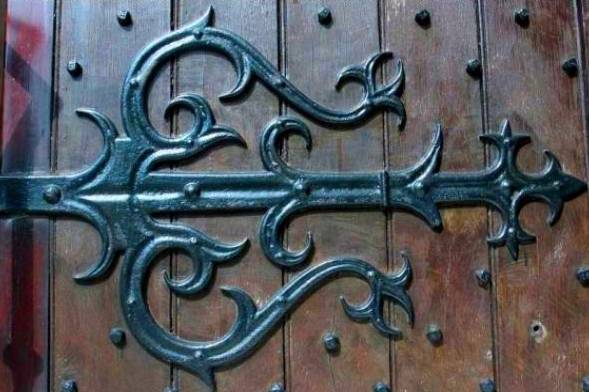


Left to right: (a) Fig. 1. (b) Fig. 2. (c) Fig. 3. Photographs by C. Widdows.
There have been two periods of major changes to the Church. Consequently it is necessary to distinguish which features belong to each era.
The front doors appear to be original, dating back to the Pugin frontage. Notice the strength of the ironwork (Fig. 1). This is designed, along with its associated inset hinge (Fig 2), as one of a pair to support a heavy studded door (Fig. 3), yet the metal work is neither rough nor thick. Once again The Tablet gives us our first record and description when the author writes: "Immediately on passing the finely-wrought doors...." This evidence is rather tenuous. Notice that the author doesn't specifically mention metalwork. However the use of the word "wrought" most probably refers to the ironwork as well as to the doors themselves. The interior doors and ironwork we see today are not the originals, and date from the Mangan alterations.
As Pugin says, the flat iron is worked, not pre-moulded, into shape. "The wrought iron is then chamfered by filing giving it a pleasing rounded delicacy that belies its strength and function." Notice, in Fig. 2, the method employed to reverse the angle of the hinge, so that this is covered when the door is closed, thereby ensuring greater security. Pugin would argue that this conforms with all three of his main principles. Figure 3 clearly shows the internal doors, dating from the 1926 extension, leading from the narthex to the nave.




Left to right: (a) Fig. 4. (b) Fig. 5. (c) Fig. 6. (d) Fig. 7. Photographs by C. Widdows.
Contrast the Pugin hinges in figures 1, 2 and 3 with those on the interior doors designed by the architect Wilfred Mangan. (Figs. 4 and 5). These are much coarser, lacking the delicacy and ornamentation of the previous ironwork. It is interesting to note that the same ironwork is also used for the outside door hinges leading to the 'new' 1926 south aisle (Fig 6). [Contrast this coarser ironwork with the finer craftsmanship of the sacristy door (Fig. 7), which is more fully discussed below]
The Sacristy Door
We now come across a conundrum: namely the existing door leading from the South aisle or Lady Chapel into the corridor to the Sacristy or vestry. Is it the original door that led from the Church into the original Sacristy?



Left to right: (a) Whole door. (b) Fig. 8. (c) Fig. 9. Photographs by C. Widdows.
The large metal work hinges (Fig. 7) look genuine and their quality is certainly superior to those we have just seen. Likewise the handle (Fig. 8) is well worked and fulfils all Pugin's criteria of propriety and ornamentation. On the reverse side of the door we also see some high quality workmanship both in the woodwork and metal work (Fig. 9). Notice that the wood planks on the outside are perpendicular whereas those on the insides they are set diagonally. The question is whether this door was the original which led from the nave into the original sacristy. It contrasts with the one leading from the Sacristy to the Sanctuary which was clearly added at a much later date, possible in the 1926 restoration or even in the 1960s.
Fig.10. Baldwin hinge. Photograph by C. Widdows.
Figure 10 shows one of the pair of Baldwin hinges on the door between the sanctuary and the sacristy. The Baldwin company was established in the late 18th century. It was a family firm based at Stourport. (Stanley Baldwin, the politician and Prime Minister was descended from the founder.) Having moved to Stourport from Shrewsbury, the firm was certainly operating at the time Pugin designed St James' Church. One query is whether the connection with Shrewsbury meant that they were known to the Talbot family and so to James Wheble, or even to Pugin.
I am very doubtful that these Baldwin marked hinges were taken from any of the original doors. Their style and quality just do not match with the other metal work we see around the church. However the firm was still in business, specialising in hinges, in the 1920s, so it is possible that the hinges were supplied then, during the Mangan alterations.
The Main West Door Lock and Key


Photographs by C. Widdows.
The main West door lock and key appear to date from the original Pugin church. The lock mechanism is bolted to the door and, as Pugin writes in the Principles..., "so far from being unsightly (they) are beautiful studs and busy enrichments." However, possibly in keeping with the greater simplicity of the Norman style, the lock itself is not decorated. The studs are interesting. Close examination of the bottom right hand stud, when the photograph is enlarged, appears to show what may be Pugin's "martlet" or stylised bird. This is however very speculative. Pugin had just begun using this now famous heraldic device in his new house, St Marie's Grange, Salisbury, in the late 1830s. Certainly all the studs show their 170 or so years' wear and details are difficult to discern. Neither the key nor the lock is as ornate as those Pugin portrays in his various books of designs. On the other hand he may have considered this more in keeping with the Norman style of architecture.
The Font
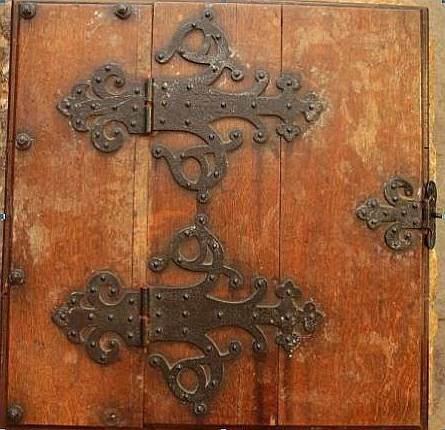
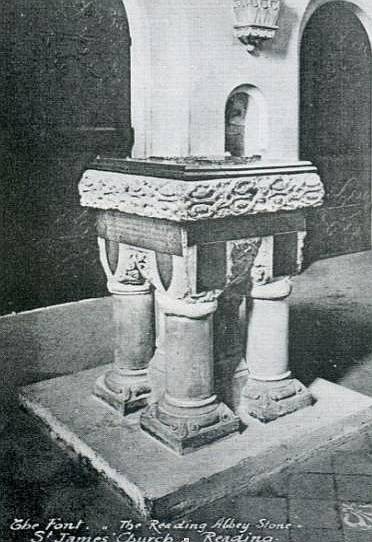
Photograph on left by C. Widdows.
We saw how the font came to be discovered, how it was originally placed at the entrance to the nave and the significance of the brass plates on two of its sides. In his letter of August 1840 to Father Ringrose, Pugin is far from complimentary about the way the font has been treated. He complains that, "the font requires lining with lead and a cover with a lock. The brass plates on the font are exceedingly ill done the purport of the inscription is good but the Letters & heraldry are in the worst possible taste."
The font was indeed subsequently lined and a cover with iron hinges and lock claspings fixed to it. It appears to have undergone several changes over the years. The ironwork however is Puginesque in style and probably dates to the 1840s. The brasses give the origin of the font and details about the opening of the church. The devices on the coats of arms are reproduced in the apse windows.
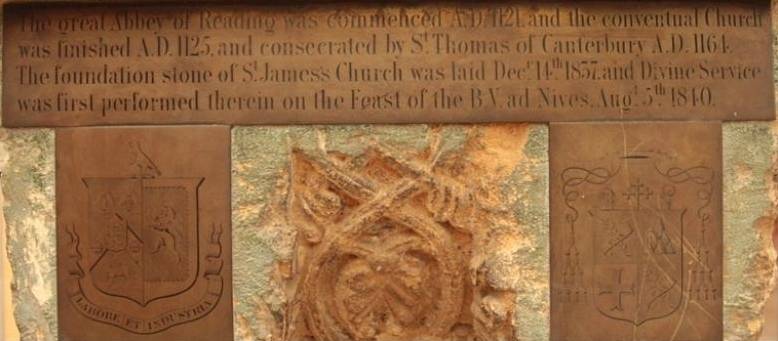

The font brasses. Photographs by C. Widdows.
The Woodwork
Principle: "The strength of woodwork is attained by bracing the various pieces together on geometrical principles. The construction of these, so far from being concealed, is turned into ornament."
In his second lecture, Pugin begins by looking at decoration "with regard to constructions in wood." As ever, he illustrates his words with examples and contrasting the ideal "ancient roofs with the framing made ornamental against the modern roof with framing concealed" [see alongside].

Pugin was totally opposed to covering the joists with plaster, although he himself did just that on at least one occasion. However, overall he retained this principle. Let us read his own words: "the strength of wood-work is attained by bracing the various pieces together on geometrical principles.... The principal tie-beams, rafters, purloins (sic), and braces, which in modern edifices are hidden at a vast expense by a flat plaster ceiling, are here rendered very ornamental features, and this essential portion of a building becomes its greatest beauty."
Ornamentation itself serves a purpose, or "appropriate meaning" as he expresses it. The carvings and paintings carry a mystical message such as the sight of angels "hovering over the congregated faithful." Carving of angels and saints, together with holy scriptural emblems, enriched with paintings of the firmament, contribute to the "mystical meaning" of a church.
St James' Roof

Fig. 1. The "queen strut" design of St. James' roof . Photograph © J. R. Mullaney.
The roof structure of St. James' remains unaltered from the time of Pugin. As such it has great architectural and historical significance, not just for St James' but also for Reading. Moreover it is indeed, arguably, the church's most attractive feature, "its greatest beauty," as Pugin himself called it.
As much of the terminology may be unfamiliar to readers two drawings of St James' roof structure are shown [...]. Figure 1 [above] shows the basic "queen strut" design as used in the church. The drawing shows what is called a "principal." Principals are the structures which are spaced along the length of the roof, marking the main bay divisions.

Top centre: Lower: Fig. 2. The labelled full roof structure of St James' Church [with photograph]. Drawing and photograph © J. R. Mullaney.
As can be seen from figure 2 this type of structure takes its name from the "queen struts": the two upright posts attached to the piece of wood which stretches across the width of the building, the tie beam. The remaining elements of the structure serve as reinforcements both to the roof itself and to its supporting beams. Partly because the roof structure in its entirety is the only remaining original piece of Pugin's design, it is also one of the most interesting. The eye is attracted by those geometric patterns which we have seen described by Pugin.
"There is neither over-embellishment nor redundant usage of braces, tie beams or principals. The main tie beams consist of two joists fastened together, with an additional shorter third support resting on the corbels. This creates extra tensile strength, such as afforded by a leaf spring."

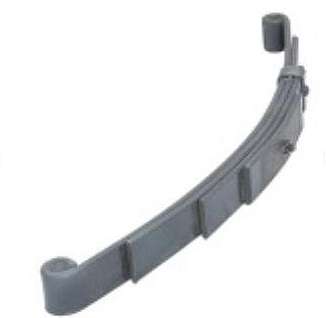
Left: Fig 3. Leaf or carriage spring. Right: Fig. 4. The Pugin roof showing the Queen Strut design at St James' Church. Photograph C . Widdows.
It is of passing interest to note that the leaf spring is one of the oldest forms of spring and was used in the Middle Ages. Pugin, with his appreciation of all things medieval, was most probably aware of this. Reinforcement and solidity are sustained by using iron clasps and bolts. The overall effect is to give the roof much greater flexibility and so resistance to wind and weather pressure.
Over the years the tie beams have been subjected to some changes. The major one was the introduction, towards the end of the 19th century, of electric lighting. The chandelier hangings, visible in an early 20th century postcard, look very like those fitted in other churches in Reading and supplied by the Reading Electrical Company. The marks of the fixings can still be discerned on the tie beams. There is also painting on much of the woodwork and the corbels. I have found no records to date to tell how much of this is original or touched up from the original.

19th or early 20th Century interior view of St James'.
Finally let us take a look at a photograph, taken from the choir loft at the end of the 19th or the beginning of the 20th century, showing many of the features we have discussed in this book. There are some changes from what members of the very first choir would have seen looking down the nave to the altar. The electric light fittings were added towards the end of the 19th or the beginning of the 20th century. But notice the gaslights between the Stations of the Cross. Also note the memorial to François Longuet. We can see a large tombstone with some form of crest just in front of Longuet's small brass plaque. Was Pugin's suggestion for a more elaborate memorial followed? Did these altar rails feature in the original design or was there a rood screen? The splayed windows in the nave are certainly fulfilling Pugin's promise of airiness and light. The 1960s alterations to the apse have detracted from the original intended function of its three windows, which was to flood the altar and sanctuary with light. However the stained glass windows, as argued above, do appear to be those we see today.
Even for those who know St James' there is so much more to be observed and discovered. For those unfamiliar with the church, a visit will offer a fascinating insight into the life, past and present, of the building and its place in the community.
St James' is a space rich in architectural heritage not merely fulfilling the needs of its thriving modern congregation but ideal for engaging with the people of Reading and beyond: a building Pugin could be proud of, as truly suited for its purpose!
Related Material
- 1. A. W. N. Pugin's First Church, St James', Reading
- 2. The Original Design and the Norman Romanesque Style
- 4. The True Principles and Their Application to St James' (Part 1)
- 5. The True Principles and Their Application to St James' (Part 2)
- 6. Bibliography and Sources
Last modified 22 December 2012